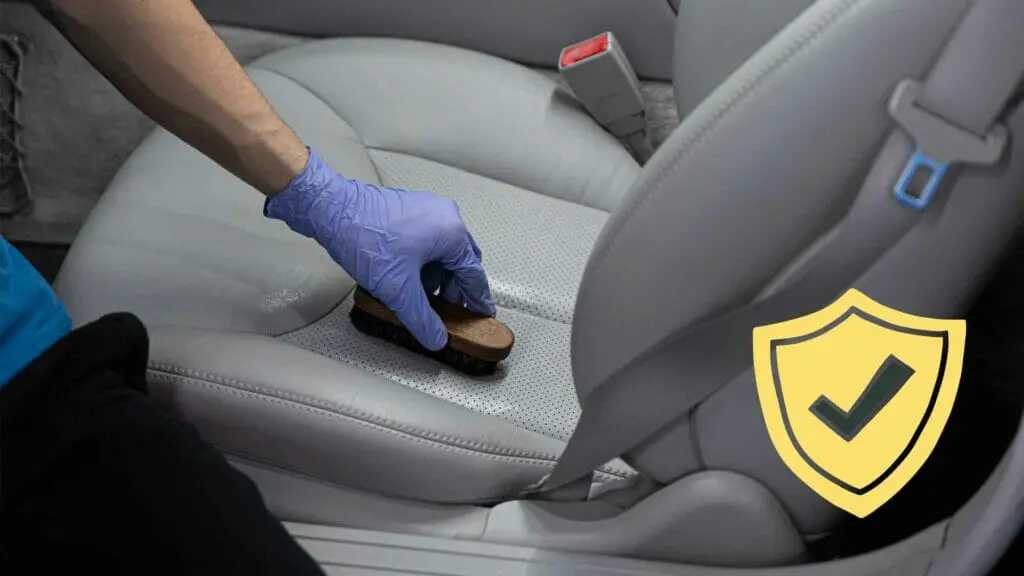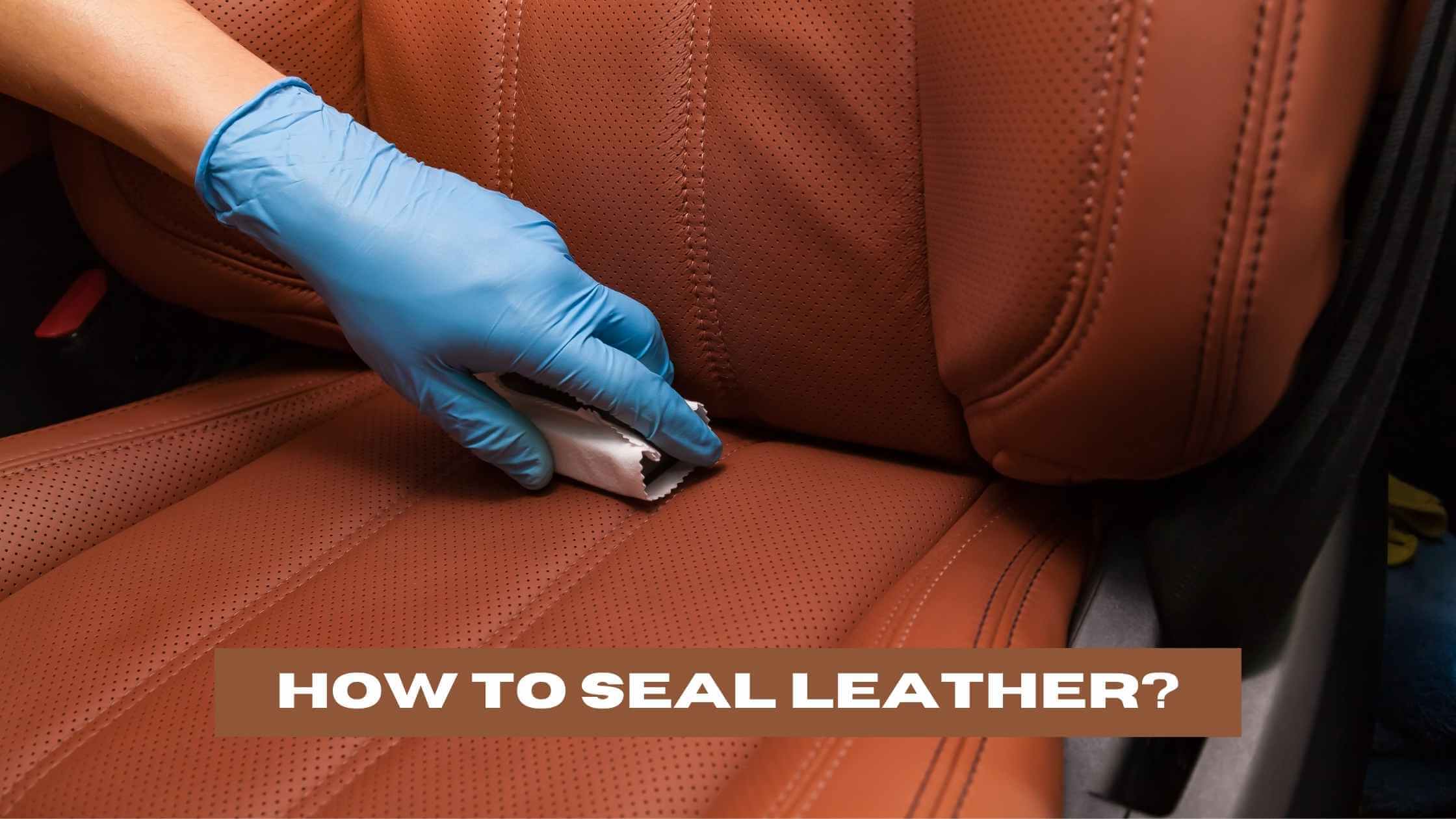If you’re here you know that sealing your leather items is essential to keep them looking their best. Whether it’s a leather jacket, boots, or a handbag, sealing leather can help prevent damage from water, stains, and other elements.
To seal leather, start by thoroughly cleaning it to remove any dirt or debris, ensuring the surface is clean. Next, choose a leather sealer appropriate for the type of leather you have, such as acrylic, polyurethane, or wax-based sealers. Apply the sealer evenly using a soft cloth or brush, covering the entire surface. Finally, allow the sealer to dry completely before using the leather item, to ensure full protection and a lasting finish.
Understanding Leather
When it comes to leather, it’s important to understand what you’re dealing with. Leather is a material made from animal hide that has been tanned to preserve it and give it a desirable texture and appearance. The quality of leather can vary greatly depending on the type of animal, the tanning process, and how it is cared for.
To ensure you get the best leather product possible, it’s important to know what to look for. The best leather should feel supple and smooth to the touch, with a consistent color and texture. Different types of leather can have different qualities – for example, cowhide is known for its durability and strength, while lambskin is softer and more delicate.
To properly care for your leather goods, it’s important to understand what they need. Leather should be cleaned and conditioned regularly to keep it from drying out and cracking. Depending on the type of leather, it may also need to be sealed to protect it from water damage and staining.
When it comes to sealing leather, it’s important to choose the right product for the job. Some leather sealers are designed specifically for furniture, while others are better suited for clothing or accessories. It’s important to read the label carefully and choose a product that is appropriate for your specific type of leather.
In general, it’s a good idea to seal new leather products to protect them from damage and ensure they last as long as possible. However, not all leather products need to be sealed – it depends on the type of leather and how it will be used. If you’re unsure whether your leather product needs to be sealed, consult with a professional or do some research online.
Preparing the Leather
Before you can seal your leather, you need to prepare it properly. This involves cleaning the leather and dyeing it if necessary. Here are the steps you should follow:
Cleaning the Leather
First, you need to clean the leather thoroughly. Use a mild leather cleaner and a soft cloth to remove any dirt, dust, or debris from the surface. Make sure to clean both the front and back of the leather. If the leather is heavily soiled, you may need to use a stronger cleaner or take it to a professional cleaner.
Dyeing the Leather
If you need to dye your leather, you should do this before sealing it. Follow the instructions on the leather dye you are using, and apply it evenly to the leather. You can use a sponge or a brush to apply the dye. Make sure to cover the entire surface of the leather, and allow it to dry completely before sealing it.
It is important to note that not all leather needs to be dyed. If you are happy with the color of your leather, you can skip this step and move on to sealing it.
Once you have cleaned and dyed your leather (if necessary), you are ready to seal it. In the next section, we will cover the steps you should follow to seal your leather properly.
Choosing the Right Sealer
When it comes to sealing leather, choosing the right sealer is crucial. Not all sealers are created equal, and using the wrong one can lead to cracking, peeling, or discoloration of your leather.
The first step in choosing a good leather sealer is to make sure it’s specifically designed for leather and not for other materials like wood or fabric. Leather sealers are formulated to be flexible, durable, and able to withstand the unique demands of leather.
There are several types of leather sealers available, each with its own benefits and drawbacks. Here are some of the most common types:
- Acrylic sealers: These are water-based sealers that dry quickly and provide a clear, matte finish. They’re easy to apply and are a good choice for light-colored leather.
- Polyurethane sealers: These are oil-based sealers that provide a glossy finish and are more durable than acrylic sealers. They take longer to dry and can yellow over time.
- Wax-based sealers: These are natural sealers that provide a matte finish and are good for waterproofing leather. They can darken the leather and require more maintenance than other types of sealers.
When choosing a sealer, it’s important to consider the type of leather you’re working with and the intended use of the item. For example, a leather jacket that will be worn in wet conditions may require a different sealer than a leather bag that will be used indoors.
Another factor to consider is the frequency of sealing. While some sealers can last for years, others may need to be reapplied every few months. Be sure to read the manufacturer’s instructions and follow them carefully.
Ultimately, the best leather sealer is one that is compatible with your leather and provides the level of protection you need. Don’t be afraid to experiment with different types of sealers until you find the one that works best for you.
Applying the Sealer

Once you have dyed your leather, it is essential to apply a sealer to protect the color and extend the life of the leather. In this section, we will discuss how to apply a leather sealer using acrylic sealer, resolene, and beeswax.
Using Acrylic Sealer
Acrylic sealer is a popular choice for sealing leather due to its ease of use and durability. Here’s how to apply it:
- Use a leather dye that is compatible with acrylic sealer.
- Once the dye has dried, apply the acrylic sealer using a soft brush or cloth.
- Apply the sealer evenly, making sure to cover the entire surface of the leather.
- Allow the sealer to dry completely before using the leather.
Acrylic sealer provides a protective layer on the leather, preventing it from cracking or fading. It is also easy to apply and dries quickly.
Using Resolene
Resolene is a water-based acrylic sealer that is ideal for sealing leather. Here’s how to apply it:
- Shake the bottle of resolene thoroughly before use.
- Using a soft brush or cloth, apply the resolene evenly on the leather surface.
- Allow the sealer to dry completely before using the leather.
Resolene provides a protective layer on the leather, preventing it from fading or cracking. It is also easy to apply and dries quickly.
Using Beeswax
Beeswax is a natural sealer that is ideal for sealing leather. Here’s how to apply it:
- Melt the beeswax in a double boiler or a microwave.
- Using a soft cloth or brush, apply the melted beeswax to the leather surface.
- Apply the beeswax evenly, making sure to cover the entire surface of the leather.
- Allow the beeswax to dry completely before using the leather.
Beeswax provides a protective layer on the leather, preventing it from cracking or fading. It is also easy to apply and provides a natural finish to the leather.
Caring for Sealed Leather
Once you have sealed your leather, it is important to take care of it properly to ensure that it lasts a long time. Here are some tips for caring for your sealed leather:
Conditioning the Leather
Conditioning your leather regularly can help keep it soft and supple. You can use a leather conditioner to do this. Apply the conditioner to the surface of the leather with a clean cloth and work it in gently. Be sure to follow the manufacturer’s instructions for the specific conditioner you are using.
Buffing the Leather
Buffing your sealed leather can help give it a nice shine. You can use a leather resolene for this. Apply a small amount of the resolene to a clean cloth and work it into the surface of the leather in a circular motion. Be sure to follow the manufacturer’s instructions for the specific resolene you are using.
It is important to note that you should not over-condition or over-buff your leather, as this can damage the surface of the leather.
Pro Tip: When conditioning your leather, be sure to test the conditioner on a small, inconspicuous area first to make sure it does not discolor or damage the leather.
Protecting Your Leather
After investing your time and money into a leather item, it is important to protect it so that it lasts for years to come. Whether it’s a leather jacket, car seats, sofa, or any other leather piece, protecting the leather is essential to maintaining its quality and beauty.
One of the best ways to protect your leather is by applying a finish to it. A leather finish is a protective coating that is applied to leather to protect it from damage and wear. There are many types of finishes available for leather, including wax, oil, resin, and acrylic. Each type of finish offers different benefits and drawbacks, so it’s important to choose the right one for your leather project.
To make your leather last longer, it’s important to apply a finish to it that is appropriate for the intended use of the leather. For example, if you are using your leather car seats frequently, you will want to use a finish that is durable and resistant to wear and tear. On the other hand, if you are finishing a leather sofa that will not be used as frequently, a softer finish may be appropriate.
When applying a finish to leather, it is important to follow the manufacturer’s instructions carefully. This will ensure that the finish is applied correctly and evenly and that it provides the maximum protection for your leather. Some finishes may require multiple coats to achieve the desired level of protection, so be sure to read the instructions carefully before beginning.
Pro Tip: One pro tip for protecting your leather is to avoid exposing it to direct sunlight and heat sources. This can cause the leather to dry out and crack, which can be difficult to repair. Additionally, avoid using harsh chemicals or cleaning products on your leather, as this can damage the finish and cause the leather to lose its natural oils.
FAQ: How to Seal Leather
What is the purpose of sealing leather?
The purpose of sealing leather is to protect it from stains, moisture, and damage. It helps to keep the leather looking good and prolongs its lifespan.
Can I seal leather after dyeing?
A: Yes, you can seal leather after dyeing. Sealing the leather after dyeing helps to lock in the color and prevent it from fading or rubbing off.
How do I seal leather?
A: To seal leather, follow these steps: 1. Clean the leather thoroughly. 2. Apply a thin and even coat of leather sealer using a soft cloth or brush. 3. Allow the sealer to dry completely. 4. Apply additional coats if desired, following the manufacturer’s instructions. 5. Buff the leather gently to enhance the shine (if desired). 6. Let the leather fully dry before using or storing it.
What is the best leather sealer?
A: The best leather sealer depends on the type of leather and your specific needs. Some popular options include acrylic leather sealers, leather sealant sprays, and wax-based sealers. It’s recommended to choose a sealer specifically designed for use on leather.
Can I use a leather sealer on any type of leather?
A: It’s important to choose the right type of sealer for the specific type of leather you are working with. Different leather types may require different sealers to achieve the best results. Always check the manufacturer’s instructions or consult a professional to determine the most suitable sealer to use.
How often should I seal leather?
A: The frequency of sealing leather depends on factors such as the level of use, exposure to elements, and the specific product used. As a general guideline, it is recommended to reseal leather every 6-12 months for optimal protection.
Can I seal leather seats?
A: Yes, you can seal leather seats. Sealing leather seats helps to protect them from spills, stains, and general wear and tear, making them easier to clean and maintaining their appearance.
Do I need to condition leather before sealing it?
A: It is advisable to condition the leather before sealing it, especially if the leather is dry or has lost its natural oils. Conditioning helps to restore moisture, flexibility, and nourishment to the leather, ensuring better results when sealing.
How long should I wait for the leather to dry before applying another coat of sealer?
A: The drying time between sealer coats depends on the specific product and environmental conditions. It is recommended to follow the manufacturer’s instructions for the recommended drying time. As a general guideline, wait until the first coat is fully dry to the touch before applying another coat.
Can I seal every part of the leather?
A: While it’s generally recommended to seal every part of the leather for consistent protection, there may be some parts, such as stitching or delicate areas, where sealing may not be necessary or may require special attention. It’s important to exercise caution and follow specific instructions provided by the leather sealer manufacturer.
Can I seal leather furniture?
A: Yes, you can seal leather furniture. Sealing leather furniture helps to protect it from spills, stains, and damage caused by everyday use. It also helps to maintain the look and feel of the leather over time.

